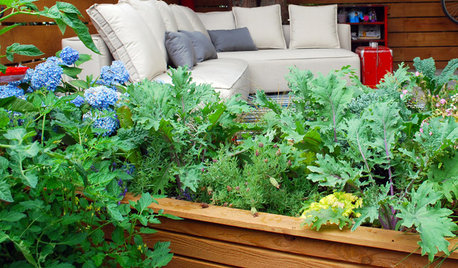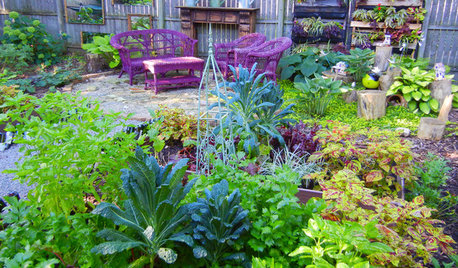New to Vegetable Gardening - Tomato Questions
JenTiffany
12 years ago
Related Stories

EDIBLE GARDENSSummer Crops: How to Grow Tomatoes
Plant tomato seedlings in spring for one of the best tastes of summer, fresh from your backyard
Full Story
EDIBLE GARDENSGarden BFFs? Why Your Vegetables Are Begging for Companion Plants
Foster friendships among plants for protection from pests, pollination support and color camaraderie
Full Story
KITCHEN DESIGN9 Questions to Ask When Planning a Kitchen Pantry
Avoid blunders and get the storage space and layout you need by asking these questions before you begin
Full Story
COLOR10 Reasons to Make a Splash With Tomato Red
You won’t duck at these tomatoes. See how bold red shades can play up architecture, light up a dark spot and add drama
Full Story
FARM YOUR YARDAdvice on Canyon Farming From L.A.'s Vegetable Whisperer
See how a screened garden house and raised beds help an edible garden in a Los Angeles canyon thrive
Full Story
FARM YOUR YARD9 Ways to Change Up Your Vegetable Garden for the Coming Season
Try something new for edible plantings that are more productive than ever
Full Story
EDIBLE GARDENS8 Surefire Vegetables and Herbs for Beginning Gardeners
Learn the edible plants that are popular and easy to grow in a backyard or container garden
Full Story
GARDENING GUIDESStep Right Outside for Fresh Herbs and Vegetables
Decks and patios can be convenient spots for edibles, and sometimes they even offer advantages over backyard gardens
Full Story
MOST POPULARHow to Start a Cool-Season Vegetable Garden
Late summer and late winter are good times to plan and plant cool-season crops like salad greens, spinach, beets, carrots and peas
Full Story
GARDENING GUIDESShades of Vegetable Gardens: Growing Edibles in Less Sun
See how one gardener produces a veritable feast of vegetables and herbs under a canopy of shade
Full StoryMore Discussions






soonergrandmom
soonergrandmom
Related Professionals
Belmont Landscape Architects & Landscape Designers · Birmingham Landscape Architects & Landscape Designers · Wheeling Landscape Architects & Landscape Designers · Surprise Landscape Contractors · Wake Forest Landscape Contractors · Laguna Hills Landscape Contractors · Nanuet Landscape Contractors · Parkland Landscape Contractors · Winchester Landscape Contractors · East Norriton Landscape Contractors · Diamond Bar Decks, Patios & Outdoor Enclosures · Fort Worth Decks, Patios & Outdoor Enclosures · Layton Decks, Patios & Outdoor Enclosures · Lebanon Decks, Patios & Outdoor Enclosures · Westminster Decks, Patios & Outdoor EnclosuresOkiedawn OK Zone 7
tulsastorm
JenTiffanyOriginal Author
susanlynne48
soonergrandmom
JenTiffanyOriginal Author
Okiedawn OK Zone 7
Lisa_H OK
elkwc
greenacreslady
soonergrandmom
Okiedawn OK Zone 7
Pamchesbay
greenacreslady
Okiedawn OK Zone 7
chickencoupe
chickencoupe
Okiedawn OK Zone 7
chickencoupe